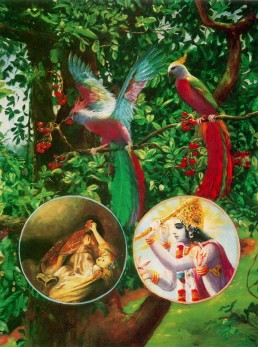Swami Chinmayananda Commentary
The idea which was hinted at in the second stanza is being taken up here to prove how the Seven Seers, the four Kumaras, and the fourteen Manus, are all born out of the Lord’s own mind, and they together constitute the MATERIAL and the EFFICIENT causes of the world, since it is stated here “FROM THEM ARE THESE CREATURES IN THE WORLD” born.
THE SEVEN RISHIS — The personified representation of the Seven Seers, as found in the Puranas, when understood “subjectively,” are nothing but one’s intellect, ego and the five sense stimuli, which, together, constitute the world experienced by each one of us (X-2).
Subjectively analysed, it is very easy for us to perceive the implication of this allegory provided by the Seven-Rishis picture. We know that when thoughts rise in us, they, in their individual manifestations, are incapable of disturbing us. At a certain moment, some desire in us gets concentrated, and, identifying with it, we maintain it in a steady stream of dynamic thoughts. Thus dynamised, the initial thought becomes mighty and powerful enough to destroy our peace and tranquillity, and projecting itself, creates the perceptions of and our reactions to the world of the five sense objects. The thought-stream and its projections together supply us with both the MATERIAL and the EFFICIENT causes for our own tiny world of joys and sorrows, victories and failures, yearning and fulfilments.
THE FOUR ANCIENTS AND THE MANUS — Sri Shankaracharya, in his commentary, reads the stanza as ‘THE ANCIENTS, AND THE FOUR MANUS,’ in the context of a subjective analysis, which is recommended and ably supported by the next line, wherein the Lord says that all of them are children of “MY MIND.”It is described in the Puranas, the Brahmaji, the Creator, at the very beginning of Creation, produced out of his own mind four eternal boys (Kumaras), Sanatkumaara, Sanaka, Sanatana, and Sanandana. The creator in us is the life in
us functioning through an ‘urge-to-create’ in any field. Whenever the creative urge expresses itself immediately the factors constituting the subtle-body (Antahkarana) express themselves and function in full vigour. When the Creator of the whole Universe comes under the ‘urge-to-express,’ he has to maintain a constant Sankalpa, which immediately produces a channel of “constant thoughts” creating the stuff for the ‘inner-instruments.’ This ‘bundle of thoughts,’ flowing constantly, functions as the mind, intellect, ego, and chit. These four factors, comprising the total inner-instrument, are represented by the Eternal Boys of Wisdom, born out of the mind of the Creator, at the very beginning of his creative activity.
Thus, in one and the same stanza, the macrocosmic (Samashti) and the microcosmic (Vyashti) causes of Creation have been indicated. Macrocosmically, the Total-intellect (Mahat), ego (Ahamkara), and the five rudimentary sense objects (tanmatras) supply the causes for the projection of the world and its sustenance, while microcosmically the ‘creative-urge’ in us gets fulfilled through the intervention and play of our inner equipment constituted of the intellect, mind, ego and chit.
The Seven Seers and the Four Ancients together indicate, thus, both the efficient and the material causes of the macrocosmic and microcosmic worlds created.
WHY SHOULD ONE UNDERSTAND THESE IMPLICATIONS OF CREATION FROM THE STANDPOINT OF THE INDIVIDUAL AND THE COSMIC MINDS?… LISTEN:
Adi Sankara Commentary
Sapta, the seven; maharsayah, great sages-Bhrgu and others; tatha, as also; catvarah, the four; manavah, Manus [Savarni, Dharma-savarini, Daksa-savarni, and Savarna.-Tr.]- well known as Savarnas; purve, of ancient days; yesam, of whom, of which Manus and the great sages; imah, these; prajah, creatures, moving and non-moving; loke in the world, are the creation; madbhavah, had their thoughts fixed on Me-they had their minds fixed on Me, (and hence) they were endowed with the power of Visnu; and they jatah, were born; manasa; from My mind-they were created by Me through My mind itself.
The Bhagavad Gita with the commentary of Sri Sankaracharya – Translated by Alladi Mahadeva Sastry
Holy Geeta – Commentary by Swami Chinmayananda
The Bhagavad Gita by Eknath Easwaran – Best selling translation of the Bhagavad Gita
The Bhagavad Gita – Translation and Commentary by Swami Sivananda
Bhagavad Gita – Translation and Commentary by Bhaktivedanta Swami Prabupadha
Srimad Bhagavad Gita Chapter 10 – Verse 6 – 10.6 maharsayah sapta – All Bhagavad Gita (Geeta) Verses in Sanskrit, English, Transliteration, Word Meaning, Translation, Audio, Shankara Bhashya, Adi Sankaracharya Commentary and Links to Videos by Swami Chinmayananda and others – 10-6

